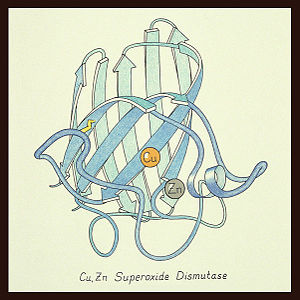Superoxide dismutase (SOD) are a group of antioxidant enzymes which catalyze the dismutation of superoxide to oxygen and hydrogen peroxide. SODs are critical antioxidative proteins, protecting the host from oxidative damage. See also
For SOD with nitrotyrosine modification see Nitrotyrosine.
Types of SOD:
uses metals as cofactors and are named accordingly: Cu-Zn-SOD, Cu-SOD, Fe-SOD, Mn-SOD. The Cu-Zn-SOD is most commonly found in eukaryotes, including humans, while Fe-SOD and Mn-SOD are found in prokaryotes. Mn-SOD is also found in eukaryotes (see 2adq and Nitrotyrosine). The 2D and 3D images above are of a Human Cu-Zn-SOD with metal ions visible.
Structure:
The function of was first determined by Irwin Fridovich and Joe McCord in 1969[1][2], with the structure of bovine SOD solved soon after by David and Jane Richardson et al. [3][4] The typical SOD structure is an 8-stranded “Greek Key” beta-barrel with an active site buried between the and . While the typical biological unit for SOD is either dimer or tetramer, monomer forms exist. The Image at the left, drawn by Jane Richardson, illustrates the Greek-Key structure and position of the metal cations.
Biochemistry
Superoxide is a highly reactive oxygen species and is a major source of oxidative stress in the body, reacting with cellular targets, often causing oxidative damage. [5] SOD protects the body by safely metabolizing the superoxide into unreactive oxygen and hydrogen peroxide. Experiments conducted with knockout mice unable to produce SOD develop widespread oxidative damage and hepatocarcinogenesis and exhibit a greatly reduced lifespan. [6] In humans, mutations to SOD1, one of 3 types found in the human body, can cause familial ALS, a motor neuron disease better known as Lou Gherig’s Disease [7], and has also been linked to Down’s Syndrome[8].
Carbon monoxide binding to the heme group at the dimeric interface modulates structure and copper accessibility in the Cu,Zn superoxide dismutase from Haemophilus ducreyi: in silico and in vitro evidences [9]
(SODs) are metalloenzymes playing a vital role in the defense mechanism against the oxidative stress; they catalyze the dismutation of superoxide, the one-electron reduction product of oxygen, to hydrogen peroxide and molecular oxygen, thus protecting living organism from oxidative lethality ( among prokaryotes and eukaryotic organisms are highlighted in different colors: SS subloop (residues Glu73-Gly93) in crimson; (Zn subloop (residues Gly94-Ala119) in salmon; (Greek key loop (residues Pro135-Gly145) in violet color; (7,8 loop (residues Ala152-Pro169) in pink color). Haemophilus ducreyi, the causative agent of the sexually transmitted human genital ulcerative disease known as chancroid, expresses one of the most interesting examples of bacterial Cu,Zn SOD (#HdSOD) with the unique feature of binding a heme molecule at the interface between the two subunits asymmetrically bound by residues , respectively (His64 and His124 are colored green and heme molecule is in yellow). The heme molecule proved to be able to bind small gaseous ligands, such as nitric oxide or carbon monoxide, as a sixth ligand thus displacing the distal histidine. In this study the structural and dynamic response of HdSOD to the (the carbon atom of CO colored in magenta and the oxigen one is in red) was studied by means of a combinations of Molecular Dynamics Simulation and X-Ray absorbtion spectroscopy and hypothesis formulated were further confirmed by in vitro experiments. All together the collected results evidenced that binding of the CO molecule produces a strong reduction in the asymmetric fluctuations of the two subunits and long range effects of the heme group on the (active site residues: His70, His72, His95, His104, His113, Asp 116 and His 151 are in cyan, Zn is in gray and Cu is in darkgoldenrod) which becomes more easily accessible to the solvent thus causing an increase in copper dismutasic activity. Based on this picture, we suggest a role of HdSOD as a heme-based-sensor protein in which conformational changes, triggered by the heme group, could help Haemophilus ducreyi to adapt at fluctuating levels of gaseous molecules, such as carbon monoxide or nitric oxide: in the presence of these gasses, the HdSOD would be able to increase its superoxide dismutation activity to subtract superoxide substrate and to prevent the formation of the dangerous peroxynitrite, the molecule generated by the reaction of nitric oxide with superoxide, which is even more harmful to the cell than superoxide. Further investigation to validate this attractive hypothesis is thus desirable.
Additional Resources
See: Copper, Zinc Superoxide Dismutase
3D Structures of superoxide dismutase
Superoxide dismutase 3D structures


